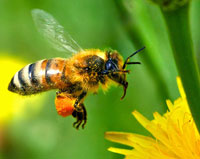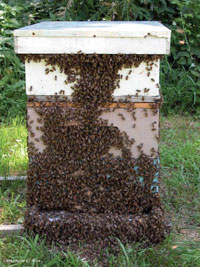 Bees belong to the insect order, Hymenoptera, which also includes wasps and ants. There are nearly 20,000 known species of bees in seven to nine recognized families. Bees occur on all continents except Antarctica.
Bees belong to the insect order, Hymenoptera, which also includes wasps and ants. There are nearly 20,000 known species of bees in seven to nine recognized families. Bees occur on all continents except Antarctica.
In mythology, Zeus, King of the Greek gods, was fed nectar from queen bees during his childhood and honey became known as Ambrosia, the food of the gods. Like the Egyptians, honey was also thought to prolong life and give strength, which we know still holds true.
- There are three kinds of bees in a hive: Queen, Worker and Drone.
- Bees go through four stages of development: Egg, Larvae, Pupae and Adult Bee.
- The honeycomb cells our used to raise babies in, and to also store nectar, honey, pollen and water.
- Nectar is a sweet watery substance that the bees gather. After they process the nectar in their stomach they regurgitate it into the honeycomb cells. Then they fan with their wings to remove excess moisture. The final result is honey.
- Each honey bee colony has a unique odour for members' identification.
- Honey bees have 170 odorant receptors, compared with only 62 in fruit flies and 79 in mosquitoes. Their exceptional olfactory abilities include kin recognition signals, social communication within the hive, and odor recognition for finding food. Their sense of smell was so precise that it could differentiate hundreds of different floral varieties and tell whether a flower carried pollen or nectar from metres away.
- To produce a pound of honey, a bee must tap into two million flowers.
- Honey bees must fly over 55,000 miles to produce one pound of honey.
- A beehive in summer can have as many as 50,000 to 80,000 bees. A bee must collect nectar from about 2 million flowers to make 1 pound of honey. It requires 556 worker bees to gather a pound of honey. Bees fly more than once around the world to gather a pound of honey.
- A worker honey bee makes only 1/12 teaspoon of honey in her life time.
- A honeybee can fly 24 km in an hour at a speed of 15 mph. Its wings beat 200 times per second or 12,000 beats per minute.
- Worker bees make 10 to 15 collection trips per day.
- The bee's brain is oval in shape and only about the size of a sesame seed, yet it has remarkable capacity to learn and remember things and is able to make complex calculations on distance travelled and foraging efficiency.
- Nurse bees heads exude Royal Jelly to feed larvae and the queen.
- Royal Jelly is a milky substance produced in a special gland in the worker bee's head. For her whole life the Queen is fed Royal Jelly by the workers.
- Wax bees secrete beeswax to build hexagonal honeycomb cells.
- The honey bee has six legs, four wings, a nectar pouch, and a stomach.
- Bees have two stomachs - one stomach for eating and the other special stomach is for storing nectar collected from flowers or water so that they can carry it back to their hive.
- Bees have five eyes - two compound eyes and three tiny ocelli eyes.
- Bees have 2 pairs of wings. The wings have tiny teeth so they can lock together when the bee is flying. Bees communicate through chemical scents called pheromones and through special bee dances.
- Honey bees have been producing honey for 10 to 30 million years.
- Modern science says it is aerodynamically impossible for bees to fly.
- A beehive appears on the Utah state seal, Utah is the beehive state.
- An estimated 220,000 U.S. beekeepers manage 3.2 million bee hives.
- A worker bee visits up to 100 flowers during one collection trip.
- Honey bees dance to communicate direction and distance of flowers.
- Annually a bee hive makes more than 400 lbs. honey and 40 lbs. pollen.
- A single beehive can make more than 100 pounds (45 kg) of extra honey. The beekeeper only harvests the extra honey made by the bees.
- The worker bees are all female and they do all the work for the hive. Workers perform the following tasks inside the hive as a House Bee: Cleaning, feeding the baby bees, feeding and taking care of the queen, packing pollen and nectar into cells, capping cells, building and repairing honeycombs, fanning to cool the hive and guarding the hive.
- Workers perform the following tasks outside the hive as Field Bees: Gathering nectar and pollen from flowers, collecting water and a collecting a sticky substance called propolis.
- Propolis is a sticky substance that bees collect from the buds of trees. Bees use propolis to weatherproof their hive against drafts or in spots where rain might leak in.
- People have discovered the anti-bacterial properties of propolis for use in the medical field.
- Bees have straw-like tongues called a proboscis so they can suck up liquids and also mandibles so they can chew.
- Worker honey bees, the girls, live 6 to 8 weeks and do all the work.
- The queen bee can live up to 5 years and is the only bee that lays eggs. She is the busiest in the summer months, when the hive needs to be at its maximum strength, and lays up to 2500 eggs per day
- Drone bees, the boys, have no stingers, and do no work, only mating.
- The male bees in the hive are called drones. Their job in the hive is to find a queen to mate with. Male bees fly out and meet in special drone congregation areas where they hope to meet a queen.
- Bees carry pollen on their hind legs called a pollen basket. Pollen is a source of protein for the hive and is needed to feed to the baby bees to help them grow.
 Queen bees, only one per hive, lay up to 2,500 eggs per day.
Queen bees, only one per hive, lay up to 2,500 eggs per day.- Apitherapy; uses bee venom, and bee products for medicinal purposes.
- Bees are the only insect in the world that make food for humans.
- Honey has natural preservatives and bacteria can't grow in it.
- Honey comes in different colours and flavours. The flower where the nectar was gathered from determines the flavour and colour of the honey.
- Honey consumption per capita in the U.S.,1.1 lbs., in Germany 9.5 lbs.
- It takes one ounce of honey to fuel a bee's flight around the world.
- Honey bees are environmentally friendly and are vital as pollinators.
- If a worker bee uses her stinger, she will die.
- U.S.D.A. estimates about 1100 honey bee stings are required to be fatal.
- Honey was found in the tombs in Egypt and it was still edible! .
- Every 3rd mouthful of food is produced by bees pollinating crops. Flowering plants rely on bees for pollination so that they can produce fruit and seeds. Without bees pollinating these plants, there would not be very many fruits or vegetables to eat.
- Beeswax is produced by the bees. Bees have special glands on their stomach that secrete the wax into little wax pockets on their stomach. The bee takes the wax and chews it with her mandibles and shapes it to make honeycomb.
- Although bears do like honey, they prefer to eat the bee larvae.
Famous People and Bee Facts
- Maine beekeeper Fred Hale was the oldest (documented) man in the world, before he died, aged 113, in November 2004. He was still driving a car at age 107 and shovelling snow at 112.
- The son of a New Zealand commercial beekeeper, Sir Edmund Hillary and his brother owned 1,200 hives. Along with Tenzing Norgay,he first scaled Mount Everest inMay 1953.
- Known for her exquisite complexion, Queen Cleopatra would bathe in milk and honey as part of her beauty regimen.
- Japanese honeybees kill hornets by enclosing them in a ball of bees, and then shaking so fast and generating so much heat that they cook the hornet at 115°F. Source
- Napoleon Bonaparte used the bee as a personal symbol of his immortality. His red cape is remembered for its bee print. Bees had been a symbol of royal families in France since the era of the Merovingian dynasty. In addition, bees were considered as the oldest emblem of the sovereigns of France.
- Ramses III, Egyptian Pharaoh, king and deity from BC 1198 to 1167, offered a lesser river god a 13,600-kilogram honey sacrifice by dumping honey into the Nile.
"If the bee disappeared off the surface of the globe, then man would only have four years of life left.
No more bees, no more pollination, no more plants, no more man."..........Albert Einstein
Sources:
http://www.abfnet.org/displaycommon.cfm?an=1&subarticlenbr=71
http://en.wikipedia.org/wiki/Bee
http://www.naturalmedications.com/health-general22/99-general/900-amazing-facts-about-honey-and-your-health
http://www.ottawacitizen.com/life/Honey+facts/6747024/story.html
http://www.agriculture.technomuses.ca/english/bees/activities/fun-facts.php
